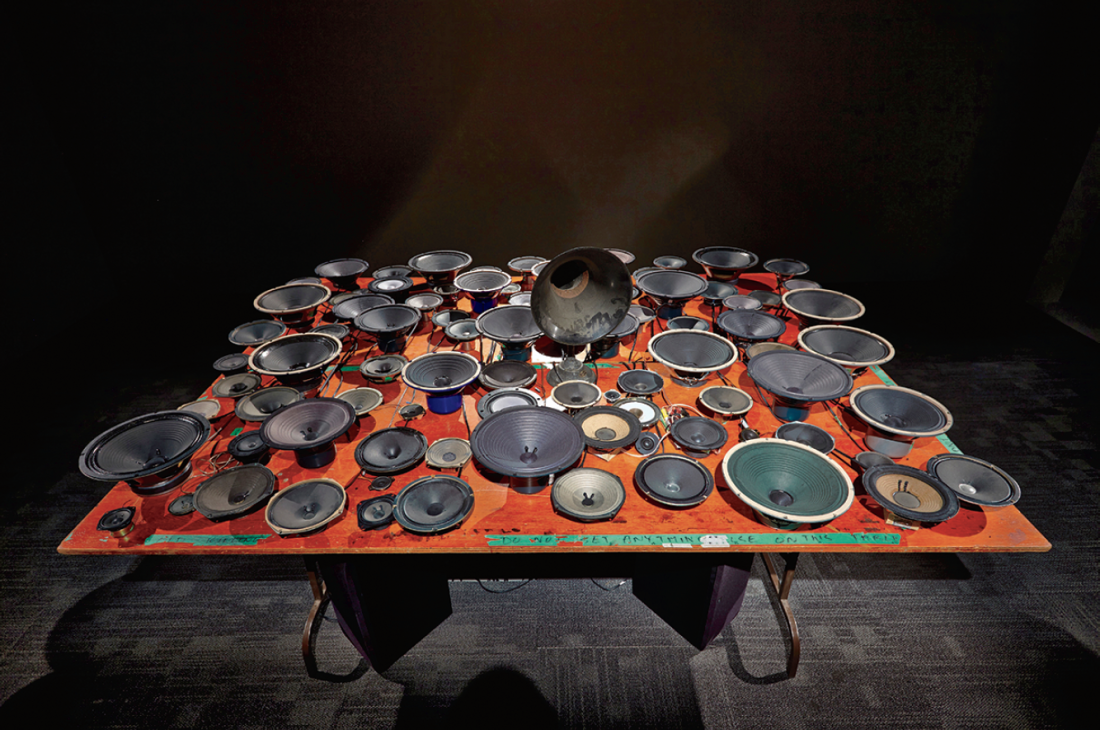Janet Cardiff and George Bures Miller
Co-curated by Kitty Scott, curator of modern and contemporary art at the Art Gallery of Ontario, and Bruce Grenville, senior curator at the Vancouver Art Gallery, Janet Cardiff and George Bures Miller’s “Lost in the Memory Palace” is an overdue first—the first Canadian-mounted survey of installation work (1995–2013) by two of this country’s most important artists. Named after an ancient mem-orization method of associating memories with particular places that one mentally explores, “Lost in the Memory Palace” forms the metaphor of museum exhibition as human mind. Its labyrinth-like design allows visitors to explore six nearby rooms that each house an installation. However, the seventh piece, Cardiff’s oft-exhibited Forty Part Motet, 2001, is located separately in the Henry Moore Sculpture Centre. The memory palace concept loosely links the other installations by highlighting Cardiff and Miller’s exploration of the nether zone between memory and physical presence, between imagistic representation and reality.
Road Trip, 2004, uses the slide presentation—a real context for displaying represented images—as a narrative intertwining with that of the slide sequence. The origin of the piece is from Miller’s discovery of slides documenting a Calgary-to-New York road trip his grandfather took in the late 1950s. As the slides are projected, visitors hear the artists conversing, noting, say, that the slides are out of order. The screen goes blank; then the slides replay as if reordered. The Muriel Lake Incident, 1999, similarly intercuts video representation with “real” dialogue. Audiences peer through a rectangular viewing window in a grey model of an empty movie theatre. The video begins suspensefully: “I’ll take care of it,” a man whispers into the telephone. Soon after, gallery visitors hear a “theatregoer” mention she fears a man standing behind her. The film stops as if damaged. A shot fires, followed by screaming and running sounds.

Janet Cardiff and George Bures Miller, Experiment in F# Minor, 2013, mixed-media interactive sound installation including 72 loudspeakers on two wooden worktables, 2.44 x 1.83 metres. © Janet Cardiff and George Bures Miller.
The Muriel Lake Incident’s ominous tone relates it to The Dark Pool, 1995. Audiences visiting The Dark Pool circle a room cluttered with rickety furniture, piles of antiquarian books, Viewmasters and giant vintage loudspeakers. Exploring this phantasmagorical collection, they activate stories of a mysterious pool called a “black hole,” of people bungee jumping over it, of someone coming up to breathe, and of a girl in a wheelchair. An open book has handwritten text that reads, “Why do I get this image of her floating in a river?”
For implying but not showing violence and death The Dark Pool is similar to their installation The Killing Machine, which was inspired by Kafka’s elaborate killing machine in his story, “The Penal Colony,” and by the backdrop of the Iraq war in 2007, when their piece was made. A kinetic sound installation, The Killing Machine centres on an empty dental chair covered with a pink fun-fur throw and lit by a glittering disco ball. Two robotic arms with ominous drill-like attachments menacingly swoop over the chair in a frenzied dance set to violin music, which is heavily accented by automated drumsticks hitting an electric guitar’s strings and an automated snare drum. Marathon Man meets Saturday Night Fever in the paradoxical juxtaposition of death and revelry that plays out on this unpopulated set that only implies a seated victim.

Janet Cardiff and George Bures Miller, Killing Machine, 2007, mixed media, sound, pneumatics, robotics. Photograph: Seber Ugarte & Lorena Lopez. © Janet Cardiff & George Bures Miller.
Both Storm Room, 2009, and Opera for a Small Room, 2005, are haunted, but by persons unknown. In the former, visitors hear footsteps and coughing in the empty room where they experience a thunderstorm simulated by computer-controlled water pouring down windows and fluorescent lights flicking on and off. Lightning-like flashes and the sounds of rain, wind and thunder build to a blinding, deafening climax. In Opera for a Small Room visitors enter a dark, makeshift room that is packed like a hoarder’s home, with sound equipment and music: eight turntables, twenty-four antique loudspeakers and two thousand stacked records. An array of voices and songs, mostly arias but occasional pop tunes too, play on turntables queued in sequence. Onlookers hear a person sifting through the albums but only witness his shadow, a corporeal trace of a real person amidst recorded, or artificial, sound.
A different exploration of shadows—using shadows as enablers—occurs in Experiment in F# Minor, 2013, commissioned by the Art Gallery of Ontario. Light sensors track visitors’ shadows as they circle two wooden worktables where 72 loudspeakers sit. The shadows prompt various tracks to overlap, forming sound mixes with an experimental, indie-rock vibe. The collective movement of viewers’ shadows ultimately creates this improvisational group performance.
Whether it is straight sound work or kinetic installation, Cardiff and Miller’s Lost in the Memory Palace merges the tangible reality of site and body with the shadow play of the imagination and of memory. The mind, consequently, does not just serve as a metaphor for the museum; it merges with it. ❚
“Janet Cardiff and George Bures Miller: Lost in the Memory Palace” was exhibited at the Art Gallery of Ontario, Toronto, from April 6 to August 18, 2013.
Earl Miller is an independent art writer and curator residing in Toronto.

